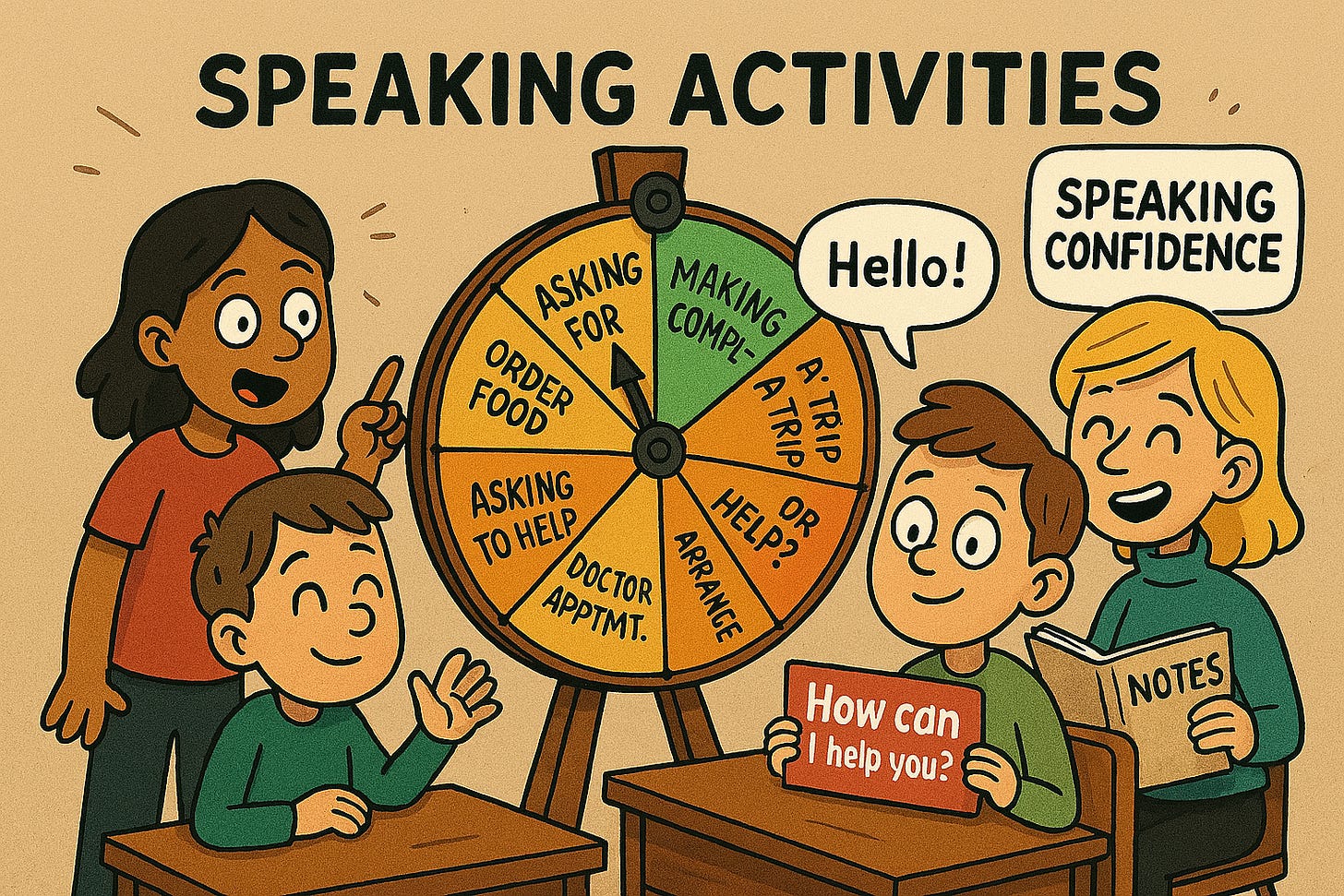How to Teach Speaking: A Step-by-Step Guide
From awkward silence to confident conversations!
Speaking is often the most desired yet most difficult skill to teach in the language classroom. Many teachers set up a speaking activity, only to be met with awkward silence or three-word exchanges. It doesn’t have to be that way.
This article will give you a step-by-step guide to planning speaking lessons that actually get students talking, participating, and improving. You’ll learn how to create purpose, build confidence, and use AI to make your life easier.
Let’s fix speaking.
What is ‘speaking’ in language learning?
Speaking is more than just saying words, it’s how we express ideas, ask for things, build relationships, and survive in real-life situations. Basically, it’s communication.
There are two main types of speaking:
Transactional, which is focused on getting something done (ordering food, asking directions)
Interactional, which is focused on building social relationships (chatting with a friend, small talk)
It involves vocabulary, grammar, pronunciation, rhythm, turn-taking, and knowing what’s appropriate in different situations. Sounds like a lot? For learners, it is.
Why speaking is essential
Although this might seem obvious, speaking is the skill most learners say they want to improve. Why? Because:
It’s the most useful skill in real life, for travel, work, socialising, exams
It reinforces other skills, using vocabulary and grammar in speaking helps fix them in memory
It builds confidence, because using the language successfully gives learners a sense of progress
If students aren’t speaking in your class, they’re missing out on all of this.
Why learning to speak is tough (and it’s not your fault)
Speaking can be one of the hardest skills for students to practise. Here’s why:
Students fear making mistakes or sounding silly
The classroom doesn’t always feel safe or supportive
Speaking activities can feel artificial or pointless
Students often don’t have the vocabulary or grammar they need for success
The result? Low-risk answers. Repetition. Silence.
It’s not that students don’t want to speak. It’s that they don’t know how to succeed at it. This can be even worse in some cultures, where the looking silly can be socially terrifying.
How to teach speaking, step-by-step
Here’s a proven structure to help you plan speaking lessons that actually work.
1. Set a clear aim
What exactly do you want students to be better at by the end of the lesson?
For example:
Making and responding to suggestions
Giving opinions in a polite way
Asking for help in a shop
Clarity helps you choose the right tasks and gives your students a clear goal. This goes back to your lesson aims.
2. Provide a strong context
Students need to know why they’re speaking. Give them a scenario, a problem to solve, or a role to play.
For example:
You and your friend are planning a weekend away. You have different budgets.
You’re working in a travel agency and your client wants something unusual.
Make it relevant, realistic, or fun. Here are some ideas on how to set a great context.
3. Pre-teach key language
Give students the tools to succeed. Pre-teach 4 to 6 useful words or phrases that they can use in the activity.
Use short, clear examples. Check understanding. Then move on.
4. Model the task
Don’t assume students know what to do. Show them. Give a mini demonstration with another student or with yourself.
Let them see what a successful conversation looks like:
How do they begin?
How do they respond?
How do they end the conversation?
5. Scaffold the practice
Start easy, then build. Use this flow:
Controlled practice (sentence matching, gap fill, dialogue reorder)
Guided practice (practice using target phrases in pairs)
Freer practice (roleplay, discussion, game)
This builds confidence and fluency gradually. Here are three ideas for scaffolding.
6. Give feedback and repeat
After the activity, give feedback. Focus on:
Useful language students tried
Common errors to improve
What went well
Then repeat the task with a new partner or context. This second attempt is almost always better.
Top Tips for Speaking Lessons
Always give a reason to speak. Tasks with a goal work better than just “talk about your weekend”
Use pair and group work to lower pressure
Don’t interrupt during speaking tasks. Take notes and correct after
Encourage risk-taking. Praise effort, not just accuracy
Limit your own talk time. Let them speak
Mix up partners to increase energy and participationy.
If you liked this article, you’ll love my books:
📝 Lesson Planning for Language Teachers - Plan better, faster, and stress-free.
👩🎓 Essential Classroom Management - Develop calm students and a classroom full of learning.
🏰 Storytelling for Language Teachers - Use the power of storytelling to transform your lessons.
🤖 ChatGPT for Language Teacher 2025 - A collection of AI prompts and techniques to work better, faster.
💭 Reflective Teaching Practice Journal - Improve your teaching in five minutes daily.



